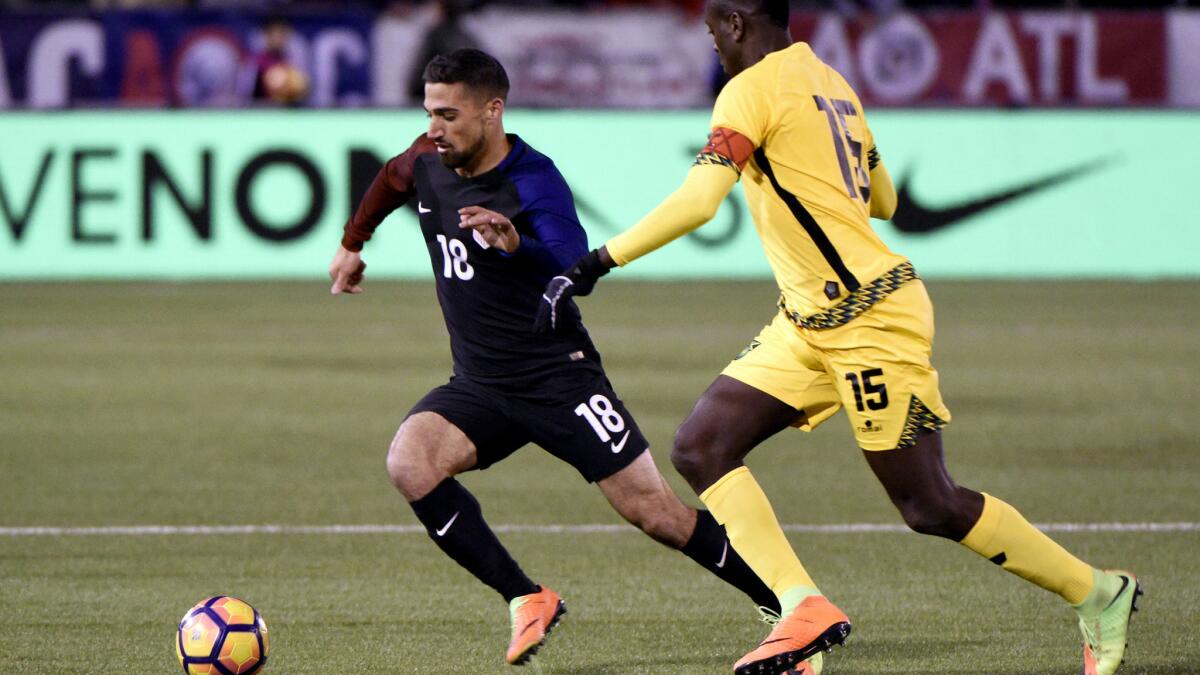Column: Shallow MLS player pool continues to hamper national team

- Share via
When the United States won the right to play host to the 1994 World Cup, one condition was the country had to form a competitive, first-tier professional soccer league.
Twenty-one years after its founding, Major League Soccer has delivered on only part of its promise. Yes, the league has grown to 22 teams from 10 and announced plans to add six more franchises in the near future. Last season, MLS claimed an average attendance of 21,692, better than first-division leagues in France, Brazil, Argentina, Portugal and the Netherlands. And its games were available on TV in more than 140 countries and territories.
But the league has not been nearly as successful on the field, where its mission to construct a pipeline sending world-class domestic players to the U.S. national team has faltered. The latest proof of that were last week’s friendlies against a young second-string Serbian team and an inexperienced Jamaican squad that had been together just three days.
These were opponents a decent team should have dominated. Instead, the U.S., with a roster featuring 21 MLS players, got just one shot on goal in a tedious 0-0 draw with Serbia and only a second-half goal from Jordan Morris in a 1-0 win over Jamaica.
Nevertheless, there were some positives to take out of Bruce Arena’s first two games with the national team in more than a decade. The defense was stout and well organized in both games and controlled the ball more than 70% of the time against Jamaica. The Americans also won for the first time in five games and four months, which should provide both confidence and momentum heading into next month’s crucial World Cup qualifiers with Honduras and Panama.
On the other hand the attack was often ponderous, producing little pressure or consistent creativity in the final third of the field. That underscored the fact the conservative MLS half of the national team lacks both speed on the wings as well as a player who can exploit opposing defenses.
It also explained why the U.S. has scored just twice in its last four games.
“We can certainly be better in the attack — and will be,” Arena said.
They’ll be better largely because they’ll be different; when the team reconvenes in six weeks, more than half its starters will come from abroad. Compare that with the English national team, whose roster for its last qualifier included 22 players from the Premier League. Or Germany’s 2014 World Cup championship team, which featured 16 players from the Bundesliga.
A country like the U.S., where an estimated 17 million people older than age 6 are playing soccer — that’s double the number in Germany and England combined — should be able to do the same. Instead, the U.S. has taken a majority-MLS roster to a World Cup just once, in 1998.
There are many theories why. Salaries in MLS are limited by a meager cap, for example, which has forced players to look overseas for better deals. And although MLS rosters featured a record 265 domestic players last season, foreign-born players were actually in the majority for three of the last five years.
Then there’s the competition. Although the level of play in MLS continues to improve, it remains light-years behind the top European leagues in both skill and technical acumen. So it makes sense that U.S. players who test the waters overseas and stick — among them Tim Howard, Geoff Cameron and Christian Pulisic – quickly lift their game to another level. Those are the examples former Coach Jurgen Klinsmann continually pointed to in trying to entice Americans players to go abroad.
Others like Sebastian Lletget, Jozy Altidore, Michael Bradley and Juan Agudelo regressed and eventually came home to become MLS stars. (In the case of Lletget, the Galaxy midfielder’s splendid play in his first two appearances with the national team figure to earn him a call-up for next month’s qualifiers.)
“I took a sacrifice, which I think a lot of players are afraid of. I took the step over to Europe to play at a big club at a young age,” Pulisic said. “That’s what is hard for a lot of people moving over: They just can’t see themselves completely moving to another country and being away from your family all the time and friends.
“It’s just taking that big step that maybe a lot of young players are afraid to do.”
The challenge now is to develop an environment in which U.S. players can stay here and develop. The league and its teams have spent millions on academy programs stretching down to the U-12 level while U.S. Soccer, under Klinsmann, overhauled its coaching-education program at the youth level to improve both the level of play and instruction.
Those are innovations that could eventually pay huge dividends for both the league and the national team — just as Klinsmann’s decision to accelerate the restructuring of Germany’s youth programs when he coached the national team there paid off with a World Cup title in Brazil.
“The real foundations for growth are going to be in the development of American players, the domestic talent,” Ivan Gazidis, chief executive for EPL club Arsenal and a MLS executive at the league’s founding, told ESPN last summer. “MLS is doing the right thing in investing in youth development, the academy system.
“That’s a long-term investment. It’s not going to happen overnight. But we’re beginning to see these young players that have come through as a product of that system. That has to be the future.”
A future, hopefully, in which the best domestic MLS players can score against a 20-year-old Serbian goalkeeper making his international debut.
Twitter: @kbaxter11




